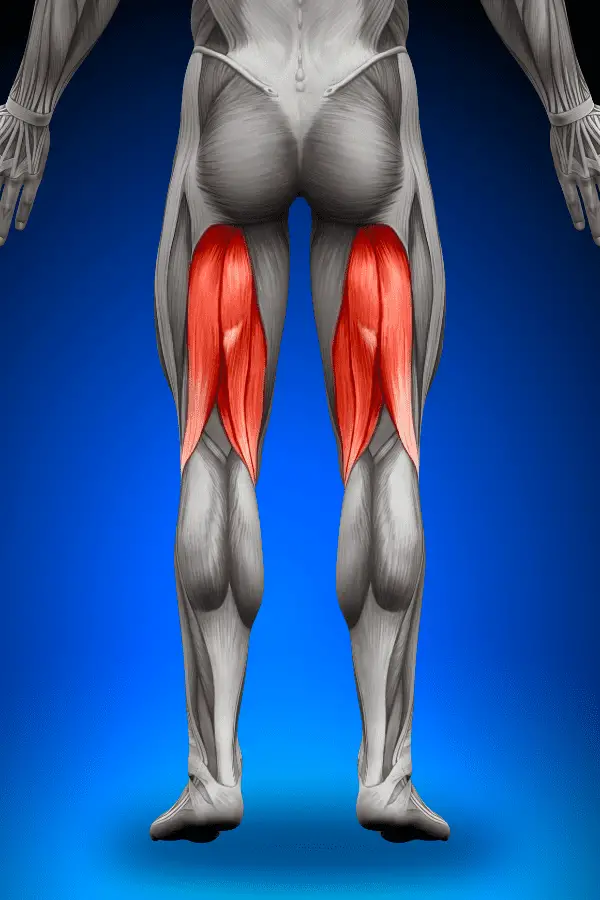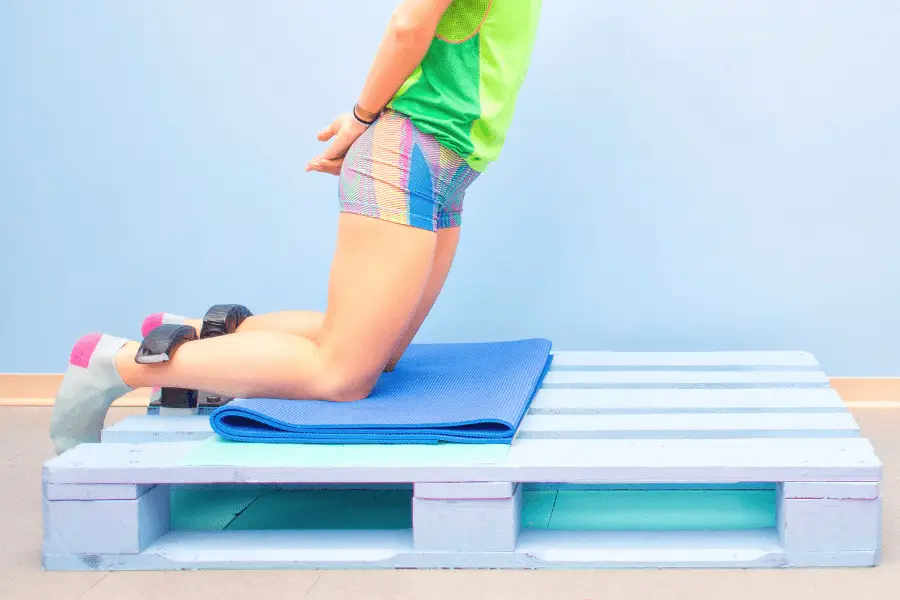Address
304 North Cardinal St.
Dorchester Center, MA 02124
Work Hours
Monday to Friday: 7AM - 7PM
Weekend: 10AM - 5PM
Are you looking for hamstring perfection? The hamstrings, are not only a key player in achieving muscular-looking legs but are also vital for athletic performance. They demand your attention. Yours seem to be lagging behind, but is training them twice a week going to be enough to reach your goals?
The hamstrings are a large muscle that takes a long time to recover. One intense workout a week is enough for most people to see muscle growth. Two workouts a week probably don’t add a lot for the hamstrings since they don’t recover quickly enough in most people. Overtraining can lead to injuries.
Below you can find out why that is the case, and how many reps and sets you should use for hamstrings.
When it comes to growing those hamstrings, finding the perfect workout frequency is key. But is training them twice a week enough for muscle growth? Let’s delve into the factors influencing hamstring training frequency and uncover the best approach for optimal growth and recovery.
Hamstrings are large muscles that take a long time to recover. One intense workout a week is enough for most people to see muscle growth. Doing 8-10 heavy sets in one workout targeting the hamstrings through either compound or isolation exercises is enough to see growth.

Hamstrings are sizeable muscles that require ample time to recover. For most individuals, one intense workout per week targeting the hamstrings with 8-10 heavy sets is sufficient to promote muscle growth effectively.
However, one workout with 8-10 heavy sets is mentally draining. So splitting those sets up into two workouts with at least 4-5 heavy sets per workout is going to be easier for most people.
More than two workouts a week means you’ll have to use fewer sets per workout or reduce the intensity. Reducing sets and intensity means you’re kind of wasting time versus just doing two hard workouts.
Exceeding two dedicated hamstring workouts per week may affect your ability to allocate adequate training time to other body parts. Considering that hamstrings are often trained alongside other large lower body muscles, recovery – both physical and mental – becomes a critical factor.
Yes, you could only do leg curls and mostly isolate the hamstrings but most people won’t do that for 10 sets a week. Usually hamstring training is done with a combination of leg curls, deadlifts, good mornings, etc.
The latter exercises put a lot of stress on surrounding muscles as well which also have to recover. The more muscle mass you train at a single time, the longer recovery will take.
The most significant muscle growth typically occurs within the first 24-48 hours after a workout, with full recovery usually taking around 48 hours.
Given that hamstrings are large muscles and often trained alongside other significant muscle groups, recovery may even take a bit longer. Consequently, fitting in more than two hamstring workouts per week can be challenging for most people.
Overtraining hamstrings can lead to significant damage and increase the risk of injuries, particularly since the hamstrings are frequently involved in athletic activities. Being mindful of overtraining helps maintain muscle health and overall fitness.
Injuring your hamstrings basically means you can’t do any other sports like football, soccer, boxing, etc for a while. If that’s important to you, getting that little bit of extra growth isn’t worth the risk.
Let’s not forget the mental aspect of training. Leg day is notorious for being demanding and not everyone finds it enjoyable.
For most individuals, one leg day a week is enough, if not plenty. Mental fatigue from intense leg workouts can also affect energy levels for subsequent training sessions, even if targeting other body parts.
So if you plan more than two heavy leg workouts a week, you can expect your other workouts to suffer. Maybe not the first two weeks but in the long run, you’ll start dreading going to the gym. I’ve been there, it’s not fun.
To emphasize hamstring growth over glutes and quads, incorporating isolation exercises like leg curls can be beneficial. Adding a hamstring-focused workout after a lower body session can streamline the process, eliminating the need for extensive warm-up sets and saving time for other exercises.
Two workouts a week is plenty for the hamstrings to grow and get stronger. There is no need to do more than two workouts a week for the hammies. That means you do have to go for a pretty high-intensity workout though. If you do the workouts right, you’ll be sore for a few days anyways.
If hamstring growth isn’t a priority, a single intense workout a week would be plenty. Try to get a workout done with 8-10 hard sets and you’re good for a week.
The ideal frequency for hamstring growth depends on various factors, including recovery time, training volume, and individual preferences. While twice a week can be sufficient for most people, striking a balance between compound and isolation exercises can help tailor a training routine that best suits your goals and keeps those hamstrings thriving. Remember to prioritize recovery and listen to your body to avoid overtraining and potential injuries. Happy lifting!
As you might understand from above that one leg day (possibly with added hamstring isolation exercises) is enough to build muscle. One more workout a week might help you grow more but you’ll notice potential recovery issues. More than 3 workouts a week is going to be problematic for many people if you do a decent amount of volume per workout. If you do more workouts, you’ll have to reduce the amount of heavy sets you do per workout to make sure you can recover properly.

One thing to understand is that the amount of workouts doesn’t say much. Compare two people working out the same body part in any gym and there will be big differences in amount of sets, repetitions, weight and effort. Working out a body part twice a week by doing a 1 bodyweight squat isn’t going to be enough for anything. Even doing that every day of the week isn’t going to do anything because that’s not something your body isn’t used to so there is no need to adapt. However, if you use heavy weights (for you), perform 8 heavy barbell squat sets aside from warmups and do that twice a week, you’ll see big results.
Everyone has to balance their training with the recovery. The more workouts you do, the fewer sets you should do per workout so you can recover in time for the next workout. In total you can still do more sets per week with more workouts but then you also start running into the problem of time. There are only so many days in the week. Focus on one body part too much and it starts cutting into the training time for other body parts.
Especially with hamstrings, you’ve got to think about what else you’re doing during the week. Playing soccer twice a week? Your hamstrings will take a beating there already, adding more than one hamstring workout is likely to result in too much fatigue and makes recovery difficult which means injuries become more likely.
There are four main factors you should get right;
As said above, there are many exercises that use the hamstrings. Most leg exercises will use the hamstrings to some degree. But to really grow the hamstrings (more than the rest of the leg), you have to do some isolation exercises on top of that. Look at exercises like the curl.
The bulk of your hamstring training is still going to come from the compound exercises. Think about deadlifts, lunges, squats, leg pressing, etc. Pick 1-2 compound lower body exercises and add leg curls on top of that if you really want to focus on the hamstrings.

4 heavy sets per week (spread out over the workouts) is considered the minimum effective dose of volume for hamstrings. That’s the minimum amount to see some growth. On the other hand it’s also not recommended to do more than 12 heavy sets per week and probably less if you’re a beginner. That is sets of direct isolation exercises or exercises that heavily target the hamstrings as part of a compound movement.
If you want one leg workout per week, aim for 8-10 heavy sets that target the hamstrings (spread out over different exercises.) If you want to do two workouts per week, aim for 10-12 sets per week. If you do more than that, recovery could become a problem. If you don’t recover fully before the next workout, the extra work can be detrimental. You might not notice this the first or second week but in the long run it will become an issue.
Read more about optimal training volume here
Hamstrings should be trained with 5-20 repetitions per set, like most other muscles. Lower repetitions (with higher weight) tends to build more strength while higher repetitions (with less resistance) build more muscle.
Using a combination of sets with low and high repetitions is a good idea to give the muscle different training impulses. This would be a good use of two workouts: one workout with heavy weight and low repetitions, the second workout with lighter weights and high repetitions.
Also, in general it’s a good idea to do the compound exercises like barbell deadlifts with heavy weights/low reps and isolation exercises like a leg curl with higher repetitions. If you only have one workout a week, it’s a good idea to change the amount of reps between exercises.
The last part of the puzzle is the weight or resistance to use. Most people will use dumbbells or barbells to work out the hamstrings but DIY solutions, bodyweight or resistance bands are also an option. In the end it doesn’t matter that much what you use, it’s all about how difficult it is for your to move that weight.
You want to use a resistance level/weight that you can complete the wanted amount of repetitions in a set with while keeping about 2-3 repetitions in reserve. Don’t go to failure on every set or even the last set of every exercise. There are several research papers about the results of training to failure but they have conflicting results. Some conclude it’s beneficial for muscle growth, others say it doesn’t matter and others yet say it’s detrimental.
Besides results the injury risk of going to failure is higher which is not worth it in my opinion. Especially not on exercises where you are under a heavy barbell. In a machine the risks are lower.
This means you have to balance between the weight being heavy enough to be challenging but not too heavy so you can’t finish all the sets. It’s a fine line that will take a while to find.

Possibly the most important thing for getting sustained muscle growth is progression. Muscle growth is the bodies way of adapting to the stress of the last workouts. That means the next workout should be a bit heavier than the last one to give the body a new level to adapt to.
The easiest way to do that is to add a small amount of weight to the exercises every workout. In the beginning, this will be pretty easy although after a while, adding weight becomes more difficult. Trying to increase the amount of repetitions can also be a good way to progress if a weight increase isn’t possible.